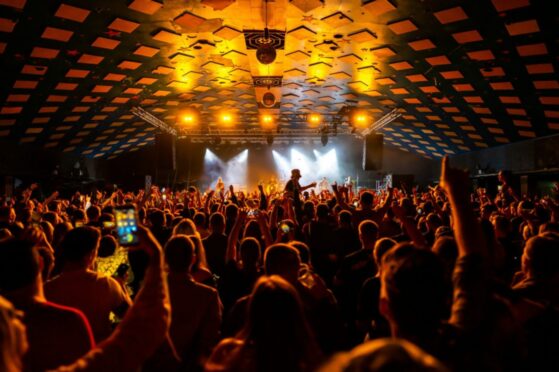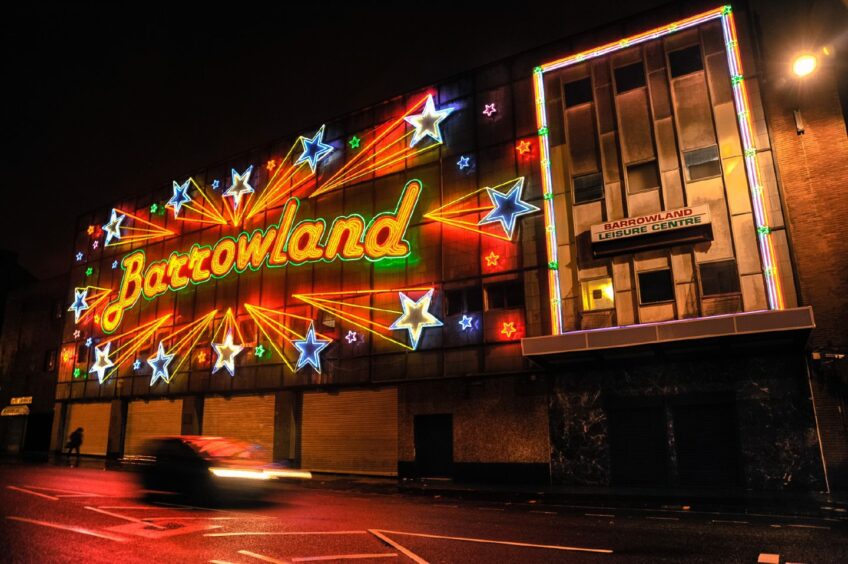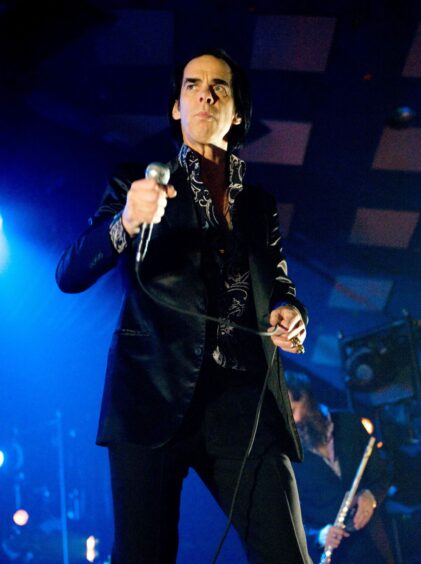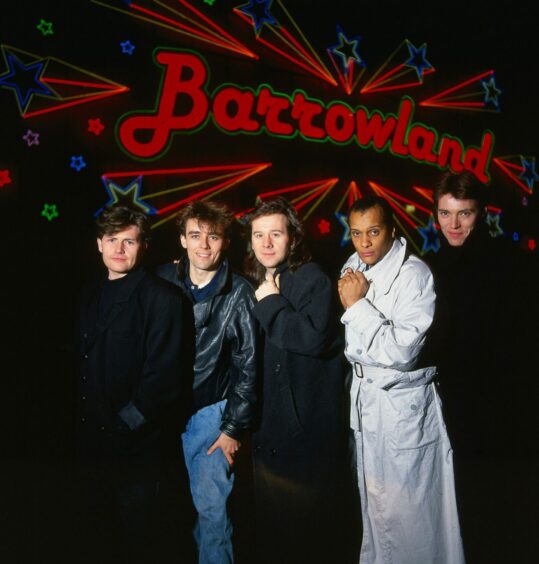
Empty, it is nothing at all, a big room full of nothing but memories.
It is at night, though, when a band is on and the floor is bouncing, the speakers are thudding and the crowd is roaring that the Barrowland comes alive.
It is one of the most famous venues in Scotland and hailed by artists around the world. Possibly every audience in every city is hailed by visiting acts as the best in the world but so many say it about the hall in the East End of Glasgow that, just possibly, it’s true.
From Bob Dylan to Oasis, David Bowie to Dave Grohl, the world’s biggest stars have played there but what is the attraction, the secret sauce that makes the Barrowland Ballroom so special?
That is the question posed by BBC Alba documentary The Barrowland Roar and presented by Stornoway musician Iain “Spanish” MacKay, as he prepares to play for the first time at the Barrowland, tracking the lure of the 88-year-old venue that lights up the neighbourhood in a blaze of neon signage.
Produced by Nick Low, the 90-minute documentary goes behind the scenes at the famous old venue, with commentary from some of the biggest Scottish names to rock the stage, including The Fratellis, Amy Macdonald, Del Amitri and Simple Minds frontman Jim Kerr, as well as Smiths legend Johnny Marr.
“The story of the Barrowland has been explored over the years but never in its fullest form, so that’s what we aimed to do,” explained Low. “We also wanted to look more specifically at the last 40 years of the venue as a concert hall and how the place as we know it today has become so iconic.
“The story goes that in 1983, Simple Minds were filming the video for their single, Waterfront, at the then barely-used Barrowland, as they were looking for a venue where they could perform a gig for the film. They invited people to come and be in the video as the audience and, as a thank you, they decided to put on a full gig for them.
“After that, they thought, we’re missing a trick here, this is an amazing venue, so they booked themselves in to be one of the first bands to perform in the venue as we know it today. After that, Big Country played, then The Clash, and then suddenly that was the Barrowland on the venue map.”
As MacKay interviews performers, one thing becomes clear – it is pretty much everyone’s favourite place to perform. Former Electronic songwriter and guitarist Johnny Marr, who has played the venue seven times with seven different acts, muses in the film: “Mad hot, insane volume, and that was before we even played a note.”
Amy Macdonald says of the Barrowland’s practically unchanged state since the ’60s: “If they ever decide to spruce it up, I’ll be devastated.”
Jon Fratelli adds: “It’s the only place I get nervous playing. It’s where we aspired to play.”
The famous Glasgow crowds, the nostalgic decor, and the size of the venue seem to be the most common answers to the constant question on MacKay’s lips – what is so special about the Barrowland Ballroom?
“The interesting thing about the building is that on the face of it, it hasn’t changed in decades but there’s actually a lot of maintenance that goes on to make it look that way,” said Low.
“There’s something that people love about these nostalgic venues, as they connect performers to the people who have come before. It’s not exactly a palatial place but everyone always loves the dressing room, the low ceilings, the 1960s-style decor. Also, it’s not a massive size, so it maintains a real intimate feel and connects acts to the audience, there’s that real eye-ball connection.
“Some acts, like Del Amitri, have turned down playing one night at bigger venues like that in place of four nights at The Barrowland, because for them it’s a far more enjoyable gig, though not as lucrative. And of course, the documentary is called The Barrowland Roar, after the world-renowned Glasgow audiences. It’s those welcoming fans that make the place tick. These three things are what we found to be the driving factor in the Barrowland’s popularity.”
Starry, starry nights: Team reveals how world famous Barrowlands keeps shows on the road
Huge names have been drawn to the venue down the years, as the Barrowland’s allure has grown over the past four decades. And so beloved is the music hall, many artists have even written songs about it.
“David Bowie played there in 1997, as did Iggy Pop in 1991 who said it’s one of the best gig venues in the world. Dave Grohl from the Foo Fighters and Nirvana played there and said it was one of the best he’d ever done,” said Low.
“This praise eventually reached the ears of Bob Dylan, so in 2004, he made it his business to go and play at the Barrowland. The reputation really draws people in internationally.
“And for those who do play there or who know the venue well, they’ve incorporated it into lyrics of their songs. Simple Minds wrote Barrowland Star, Irish folk singer Christy Moore wrote Barrowland and in Amy Macdonald’s song Barrowland Ballroom, she remembers a time she wondered if David Bowie had ever played at the venue – which, of course, he did.”
The ballroom was built in 1934 by Maggie McIver, known as the Barra’s Queen, as a dance hall for traders at neighbouring Barras market. Following a devastating fire in 1958, it was rebuilt by 1960. Until Simple Minds’ gig in 1983 led to its re-christening as a concert venue, it had been a roller disco hall.
While world-renowned acts have graced the stage since, the venue also has a strong connection to the Gaelic community and folk performers, as is also explored in the documentary.
As MacKay explains: “Standing here, it feels very important. This sprung floor was built for dancing and it’s seen lots of that over the years.”
Following a Runrig gig in the ’80s, it was decided the dancefloor had to be reinforced to ensure it could carry the weight of 2,000 jumping fans, and steel pillars were installed. The Gaelic rockers, meanwhile, paved the way for more trad-rock performers to be drawn to the famous stage in the city’s Gallowgate. MacKay is in good company as he prepares to join folk band Trail West to sing his song Cast My Wish Upon The Sea in a bastion of Gaeldom.
“Because the documentary was for BBC Alba, we wanted to reflect that relationship that the Highlands and Islands have with the Barrowland, which at first seems a bit of a strange one, but there is actually a huge community of Gaelic speakers and people from the Highlands and Islands in Glasgow,” said Low.
“So they always come to see the Celtic bands. The Vatersay Boys have been playing for 10 years and it became an annual tradition to see them at the Barrowlands, and off the back of that you have bands like Trail West, Tide Lines, Skippenish and Niteworks also wanting to play there. We wanted to reflect the new talent, as well as the old – all the new bands that are paving the way for a new generation of stars.”
Three to remember
David Bowie
Rumour has it, when Bowie played the Barrowland in 1997, he stole one of the famous stars that adorn the dancehall ceiling and band room. It led to rumours that anyone else who plays there now steals a star.
Biffy Clyro
In 2014, the Ayrshire band staged a three-night residency at their favourite venue, playing a selection of music from their first six albums as voted for by fans.
The trio performed 80 songs across the three shows. The achievement is now honoured by the group’s lyrics which adorn the Barrowland stairs.
Simple Minds
The Barrowland’s blossoming as a concert venue starts with the Glasgow rockers who chose it as the location for the video accompanying their landmark 1983 single Waterfont.
The band, fronted by Jim Kerr, installed lighting support equipment to put on a spectacular show for fans and left the rigging as a gift to their home town venue and future headliners.
The Barrowland Roar, BBC Alba, tonight, 9pm

Enjoy the convenience of having The Sunday Post delivered as a digital ePaper straight to your smartphone, tablet or computer.
Subscribe for only £5.49 a month and enjoy all the benefits of the printed paper as a digital replica.
Subscribe
 © Duncan Bryceland/Shutterstock
© Duncan Bryceland/Shutterstock © Alamy
© Alamy